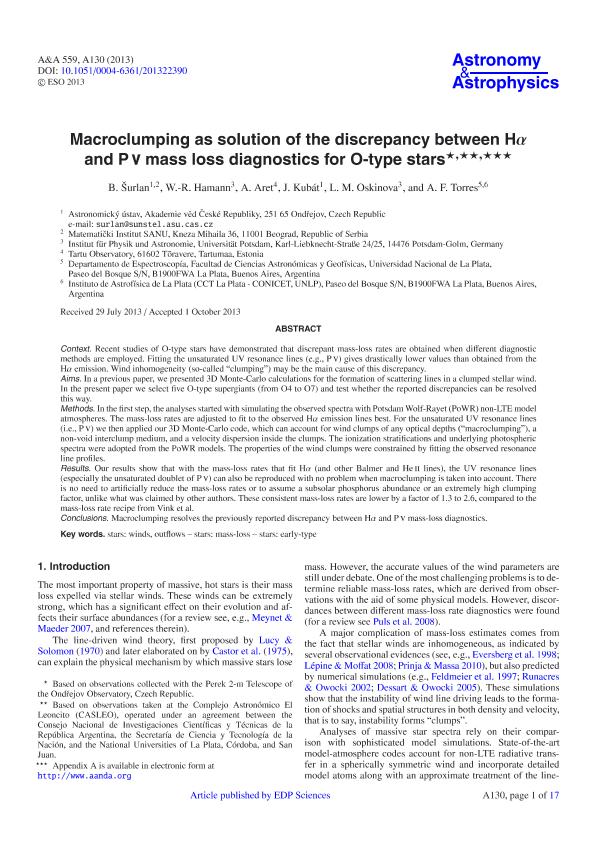Mostrar el registro sencillo del ítem
dc.contributor.author
Surlan, B.
dc.contributor.author
Hamann, W. R.
dc.contributor.author
Aret, A.
dc.contributor.author
Kubát, J.
dc.contributor.author
Oskinova, L. M.
dc.contributor.author
Torres, Andrea Fabiana

dc.date.available
2016-12-01T17:14:22Z
dc.date.issued
2013-11
dc.identifier.citation
Surlan, B.; Hamann, W. R.; Aret, A.; Kubát, J.; Oskinova, L. M.; et al.; Macroclumping as solution of the discrepancy between Halpha and P V mass loss diagnostics for O-type stars; Edp Sciences; Astronomy And Astrophysics; 559; A130; 11-2013; 1-17
dc.identifier.issn
0004-6361
dc.identifier.uri
http://hdl.handle.net/11336/8581
dc.description.abstract
Context. Recent studies of O-type stars have demonstrated that discrepant mass-loss rates are obtained when different diagnostic methods are employed. Fitting the unsaturated UV resonance lines (e.g., P v) gives drastically lower values than obtained from the Hα emission. Wind inhomogeneity (so-called “clumping”) may be the main cause of this discrepancy.
Aims. In a previous paper, we presented 3D Monte-Carlo calculations for the formation of scattering lines in a clumped stellar wind.In the present paper we select five O-type supergiants (from O4 to O7) and test whether the reported iscrepancies can be resolved this way.
Methods. In the first step, the analyses started with simulating the observed spectra with Potsdam Wolf-Rayet (PoWR) non-LTE model atmospheres. The mass-loss rates are adjusted to fit to the observed Hα emission lines best. For the unsaturated UV resonance lines (i.e., P v) we then applied our 3D Monte-Carlo code, which can account for wind clumps of any optical depths (“macroclumping”), a non-void interclump medium, and a velocity dispersion inside the clumps. The ionization stratifications and underlying photospheric spectra were adopted from the PoWR models. The properties of the wind clumps were constrained by fitting the observed resonance line profiles.
Results. Our results show that with the mass-loss rates that fit Hα (and other Balmer and He ii lines), the UV resonance lines (especially the unsaturated doublet of P v) can also be reproduced with no problem when macroclumping is taken into account. There is no need to artificially reduce the mass-loss rates or to assume a subsolar phosphorus abundance or an extremely high clumping factor, unlike what was claimed by other authors. These consistent mass-loss rates are lower by a factor of 1.3 to 2.6, compared to the mass-loss rate recipe from Vink et al.
Conclusions. Macroclumping resolves the previously reported discrepancy between Hα and P v mass-loss diagnostics.
dc.format
application/pdf
dc.language.iso
eng
dc.publisher
Edp Sciences

dc.rights
info:eu-repo/semantics/openAccess
dc.rights.uri
https://creativecommons.org/licenses/by-nc-sa/2.5/ar/
dc.subject
Winds
dc.subject
Outflows
dc.subject
Mass Loss
dc.subject
Early Type Stars
dc.subject.classification
Astronomía

dc.subject.classification
Ciencias Físicas

dc.subject.classification
CIENCIAS NATURALES Y EXACTAS

dc.title
Macroclumping as solution of the discrepancy between Halpha and P V mass loss diagnostics for O-type stars
dc.type
info:eu-repo/semantics/article
dc.type
info:ar-repo/semantics/artículo
dc.type
info:eu-repo/semantics/publishedVersion
dc.date.updated
2016-11-18T15:10:41Z
dc.journal.volume
559
dc.journal.number
A130
dc.journal.pagination
1-17
dc.journal.pais
Francia

dc.journal.ciudad
Paris
dc.description.fil
Fil: Surlan, B.. Astronomický Ústav, Akademie Ved ; República Checa. Matematicki Institut Sanu; Serbia
dc.description.fil
Fil: Hamann, W. R.. Universität Potsdam. Institut Für Physik Und Astronomie; Alemania
dc.description.fil
Fil: Aret, A.. Tartu Observatory; Estonia
dc.description.fil
Fil: Kubát, J.. Astronomický Ústav. Akademie Ved; República Checa
dc.description.fil
Fil: Oskinova, L. M.. Universität Potsdam. Institut Für Physik Und Astronomie; Alemania
dc.description.fil
Fil: Torres, Andrea Fabiana. Consejo Nacional de Investigaciones Científicas y Técnicas. Centro Científico Tecnológico la Plata. Instituto de Astrofísica de la Plata; Argentina
dc.journal.title
Astronomy And Astrophysics

dc.relation.alternativeid
info:eu-repo/semantics/altIdentifier/doi/http://dx.doi.org/10.1051/0004-6361/201322390
dc.relation.alternativeid
info:eu-repo/semantics/altIdentifier/url/http://www.aanda.org/articles/aa/abs/2013/11/aa22390-13/aa22390-13.html
Archivos asociados
